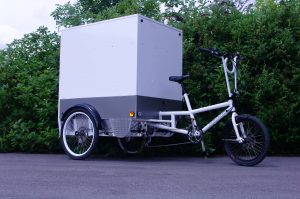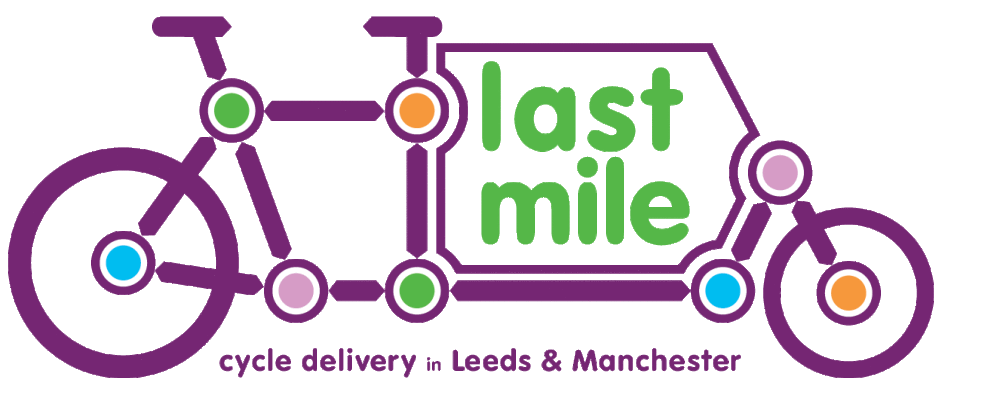‘We’re gonna’ need a bigger bike’ – why we have ordered an Iceni Trike
Last Mile Trikes
Last Mile began working with TNT late last year and quickly realised that the profile of consignments we would be receiving, would be getting larger, and that we needed something larger than our workhorse Bullitts.
For a good many months we have managed with an extra long Workcycles Bakfiets with electric assist. With approximately double the load capacity of the Bullitt in our specially designed box, we have certainly pushed this bike to the limit of a 2-wheeler.
We later purchased a second-hand Maximus and have fitted a large volume box (approx. 1.7m3) to the back with a hatch back style lift up door. Without electric assist this is somewhat slow, and it’s not very popular with my staff, but the ridiculously low gear ratio means that while it certainly plods up the hills it can carry bucket loads.
Nevertheless, we have been encouraged to look elsewhere for something that will help us deal with our increasing load volumes.
The Iceni Trike
I first rode the Iceni Trike at the ECLF conference in Vienna, and my initial thoughts were that it was too small. I have already expressed my concern about the shift to bigger and bigger bikes but, if I am going to commit to a trike with all the disadvantages compared to a 2-wheeler then it had better be able to carry lots. Volume is the key criterion over weight, but riding it compared to the Maximus didn’t feel like I was riding a large volume trike.
So, I was surprised to find out that the cargo box fitted to the test trike had a capacity of 1.4m3. This is slightly smaller than our Maximus but not by much, and it feels and rides like a much smaller cycle. Probably the biggest difference between the Iceni and pretty much every other trike on the market, is the choice to use stub axles. This break with traditional design means that rather than carrying the load on top of a triangular chassis with a wheel at each corner, the Iceni has a frame construction which creates a space for the load between the two back wheels. Thus the load is carried lower giving a lower centre of gravity and a more stable ride. Many of the design decisions, follow on from this.
Sceptical of this I began further discussions with Adam, the designer and builder of the Iceni, and frankly he is one of the most impressive aspects of the package. There seems to be nothing that he hasn’t given thought to; from the stem angle which is raked to improve stability and reduce vibration, or the choice of ‘off the shelf’ bike parts to make ongoing maintenance easier, to the ‘monococque’ chassis which looks terribly light weight in comparison to traditional trike designs, but I was persuaded by spreading the frame around the load can be both lighter and stronger.
Of course, I’m no expert and to a large extent I took much of what Adam explained on trust. Nevertheless, I was sufficiently impressed by the Iceni to want to use it in anger to deliver freight on the streets of Leeds. I arranged a trial of a few weeks and made sure that all of my riders gave it a go.
From my own experience, I found that my route choice changed subtly when I was on this trike. The electric assist was a joy to use and I was quite happy to cycle a little further rather than take the sort of shortcuts I would always choose on a non-assisted Bullitt. It was also small and maneuverable enough to avoid the tendency to park and walk as I am sometimes inclined to do more often with our large trike, but would never do on a 2-wheeler.
The Iceni Cargo Box
The standard Iceni trike is configured as a pick-up, but our test model carried an early version of their cargo back consisting of a large square box with double doors at the rear.
The motor and battery are easily the heaviest components on the bike and are even likely to be denser than many loads that the trike carries, so dropping the load bed and putting the motor between the wheels is great for handling. But there are one or two drawbacks, as the motor occupies prime cargo real estate directly between the wheels at the base of the cargo box. It creates two dead spaces either side of the motor which are difficult to utilise efficiently. This can be further exacerbated as the standard position for the battery is on the bottom of the cargo box, but the current battery doesn’t fit neatly into the space beside the motor. Apparently the next iterations of the Heinzmann motor may allow a variety of different batteries to be used, which should allow batteries that will fit into this ‘dead space’ to be used. There are obviously alternative places the battery can be mounted, outside the box, which would also make it easier to get at when the bike is loaded.
I don’t know whether the calculated volume of the cargo box has allowed for these unwelcome intrusions. I suspect the usable space is somewhat less than the 1.4m3 declared volume, but overall I feel that a volume approximately four times that of our largest 2-wheeler will still offer significant advantages.
The Iceni on the Road
Mounting the box about 20-30cm lower than would be the case with a conventional design means that the rider has a somewhat unobstructed line of sight over their shoulder, to the road behind them. Personally, I would sacrifice this rear view for increased load carrying capacity as I have found wing mirrors provide a sufficient rear view, but one of the complaints I have had from some of my riders who aren’t drivers is that making the step up from a Bullitt which when all is said and done is only as wide as a regular set of handlebars to something which occupies road space like a small car is harder for those with no driving experience.
There is also an argument that if a cargo trike is to be used alongside regular cycles on cycle specific infrastructure then it should not obstruct the view forwards of riders approaching from behind and about to overtake, but in the UK there are very few situations where cycles reach this density—especially outside rush hour when the majority of our deliveries are made.
Certainly, my staff were much happier to take out the Iceni than the non-electric assist Maximus, though it is hardly a fair comparison. I am planning to electrify one of our Maximus with the very same Heinzmann kit on the Iceni so it will be very interesting to compare the two then. I really thought of our trial as an opportunity to test the benefits of trikes in general, but the positive feel of riding the Iceni was such that I immediately committed to buy one and we are currently awaiting the arrival of our new trike in time for the build-up in volumes on the way to Christmas.
I liked both Adam and his design, and would love to see Iceni succeed as a company, but I wouldn’t buy a trike that I didn’t think was going to work for us in Leeds. Watch this space, and in a few months’ time we will be able to give a fuller review of our new trike, informed from real experience and an extended road test.
